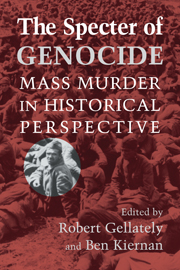Book contents
- Frontmatter
- Contents
- List of Contributors
- Acknowledgments
- INTRODUCTION
- PART I GENOCIDE AND MODERNITY
- PART II INDIGENOUS PEOPLES AND COLONIAL ISSUES
- PART III THE ERA OF THE TWO WORLD WARS
- PART IV GENOCIDE AND MASS MURDER SINCE 1945
- 13 “When the World Turned to Chaos”
- 14 Genocide in Cambodia and Ethiopia
- 15 Modern Genocide in Rwanda
- 16 History, Motive, Law, Intent
- 17 Analysis of a Mass Crime
- CONCLUSIONS
- Appendix: Convention on the Prevention and Punishment of the Crime of Genocide
- Index
13 - “When the World Turned to Chaos”
1965 and Its Aftermath in Bali, Indonesia
Published online by Cambridge University Press: 05 June 2012
- Frontmatter
- Contents
- List of Contributors
- Acknowledgments
- INTRODUCTION
- PART I GENOCIDE AND MODERNITY
- PART II INDIGENOUS PEOPLES AND COLONIAL ISSUES
- PART III THE ERA OF THE TWO WORLD WARS
- PART IV GENOCIDE AND MASS MURDER SINCE 1945
- 13 “When the World Turned to Chaos”
- 14 Genocide in Cambodia and Ethiopia
- 15 Modern Genocide in Rwanda
- 16 History, Motive, Law, Intent
- 17 Analysis of a Mass Crime
- CONCLUSIONS
- Appendix: Convention on the Prevention and Punishment of the Crime of Genocide
- Index
Summary
In May 1998, when Suharto stepped down from the presidency of Indonesia, a torrent of talk was unleashed about the past, present, and future of the country he had ruled for more than thirty-two years. As censorship of the media was lifted and as laws prohibiting the formation of political parties were repealed, a newly vibrant civil society began to overflow with optimism and openness. From the halls of the People's Consultative Assembly in Jakarta to the small warung food stalls that serve as gathering places for the archipelago's poor, one word was being uttered that seemed to condense a national consciousness: reformasi, the new era that would leave the legacy of Suharto's “New Order” regime behind.
But even as Indonesia was looking to its future with a heady sense of hope, the fall of Suharto saw stories emerge into public culture that had long been silenced. Reports began to be heard of military murders, torture, and sexual violence in Aceh and East Timor. Tales began to be told of the everyday terror of living under a regime committed to surveillance of its population and to spectacles flouting its military might. And people began – some haltingly, some looking warily over their shoulders, and a few more boldly – to speak about the inaugural events of Suharto's rule: the violence of 1965, in which up to 1 million people were brutally killed over the span of a few bloody months.
- Type
- Chapter
- Information
- The Specter of GenocideMass Murder in Historical Perspective, pp. 289 - 306Publisher: Cambridge University PressPrint publication year: 2003
- 19
- Cited by



